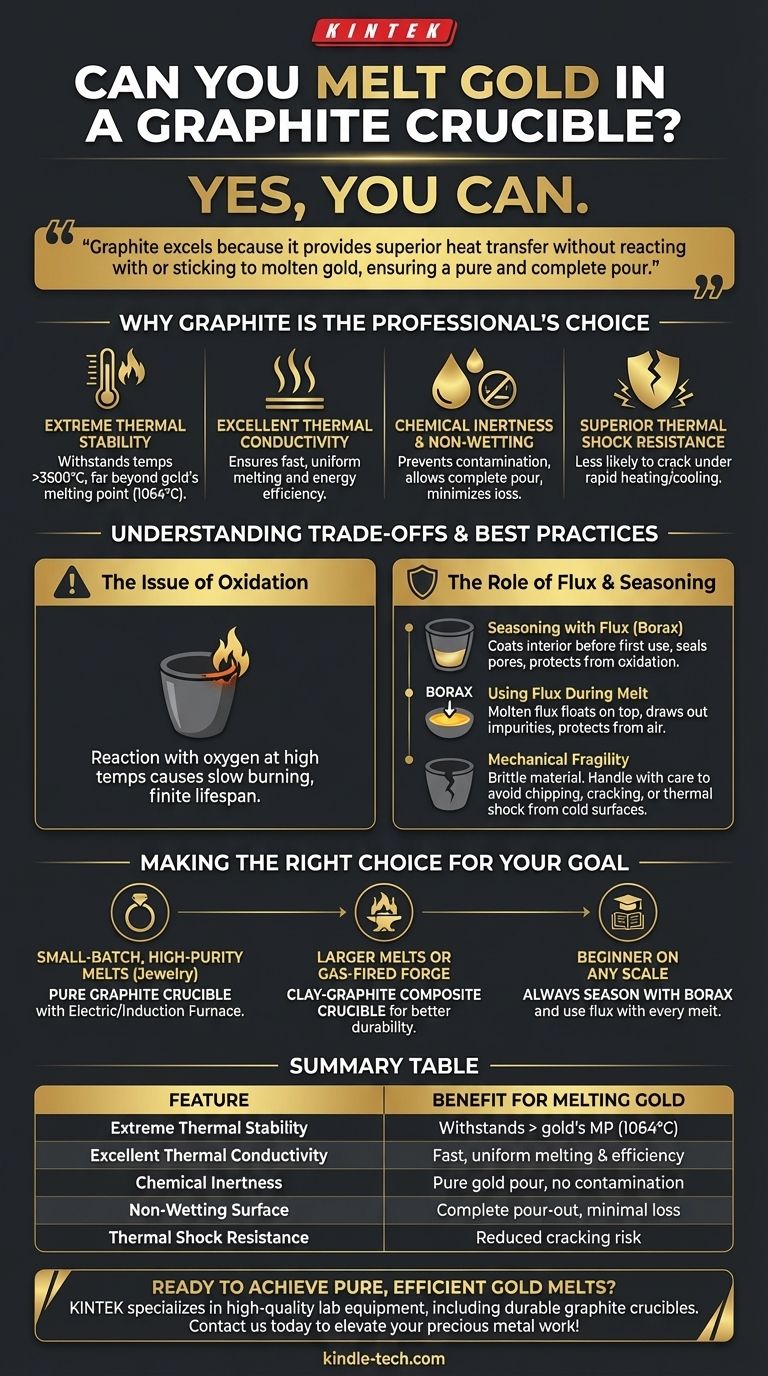Yes, you can. In fact, graphite crucibles are the industry standard for melting gold, silver, and other precious metals. Their unique combination of extreme heat tolerance, chemical inertness, and thermal conductivity makes them an exceptionally reliable and efficient choice for this task.
The critical factor in melting precious metals isn't just finding a container that won't melt, but one that won't contaminate your valuable material. Graphite excels because it provides superior heat transfer without reacting with or sticking to molten gold, ensuring a pure and complete pour.

Why Graphite is the Professional's Choice for Melting Gold
The suitability of a graphite crucible goes far beyond simply holding hot metal. Its specific material properties are what make it the ideal tool for metallurgists, jewelers, and refiners.
Extreme Thermal Stability
Gold melts at approximately 1064°C (1948°F). Graphite's sublimation point is over 3600°C (6500°F), meaning it can withstand temperatures far beyond what's needed to melt gold without degrading, warping, or failing.
Excellent Thermal Conductivity
Graphite conducts heat exceptionally well. This ensures that the heat from your torch or furnace is transferred evenly and efficiently throughout the gold, resulting in a faster, more uniform melt and reducing energy waste.
Chemical Inertness and Non-Wetting Properties
This is perhaps the most critical feature. Molten gold does not chemically react with carbon, so the graphite will not contaminate your pour. Furthermore, gold does not "wet" or stick to the graphite surface, allowing you to pour out every last drop and minimize costly losses.
Superior Thermal Shock Resistance
Crucibles undergo immense stress when heated and cooled rapidly. Graphite is highly resistant to thermal shock, meaning it is far less likely to crack or shatter during the melting process compared to many ceramic alternatives.
Understanding the Trade-offs and Best Practices
While graphite is the ideal material, it is not indestructible. Proper handling and preparation are essential for safety, crucible longevity, and a successful melt.
The Issue of Oxidation
Graphite's main vulnerability is its reaction to oxygen at high temperatures. When heated with a direct flame (like a propane torch), the surface layer of the crucible will slowly burn away, or oxidize. This means the crucible has a finite lifespan and will gradually get thinner with each use.
The Need for Seasoning with Flux
Before its first use, a graphite crucible should be "seasoned." This involves coating the interior with a flux, typically borax, and heating it until the borax melts into a smooth, glassy layer. This glaze seals the pores of the graphite, preventing the absorption of fine metal particles and providing an extra barrier against oxidation.
The Role of Flux During a Melt
Using borax as a flux during the melting process is also standard practice. The molten flux floats on top of the gold, drawing out impurities from the metal and protecting both the gold and the crucible itself from airborne oxygen.
Mechanical Fragility
While thermally robust, graphite is a brittle material. It can be easily chipped, cracked, or broken if dropped or handled carelessly. Always use properly fitting tongs and avoid placing a hot crucible on a cold or wet surface, which could cause a catastrophic thermal shock fracture.
Making the Right Choice for Your Goal
By understanding the properties and proper use of your equipment, you can ensure a safe and efficient process.
- If your primary focus is small-batch, high-purity melts for jewelry: A pure graphite crucible is an excellent choice, especially when used with an electric or induction furnace that minimizes direct oxidation.
- If your primary focus is larger melts or using a gas-fired forge: A more durable clay-graphite composite crucible provides better mechanical strength and resistance to the direct-flame oxidation from a torch.
- If you are a beginner on any scale: Always start by properly seasoning your crucible with borax, and continue to use flux with every melt to protect your investment and purify your gold.
Choosing the right crucible is the first step toward mastering the process of working with precious metals.
Summary Table:
| Feature | Benefit for Melting Gold |
|---|---|
| Extreme Thermal Stability | Withstands temperatures far beyond gold's melting point (1064°C) |
| Excellent Thermal Conductivity | Ensures fast, uniform melting and energy efficiency |
| Chemical Inertness | Prevents contamination and ensures a pure gold pour |
| Non-Wetting Surface | Allows complete pour-out, minimizing precious metal loss |
| Thermal Shock Resistance | Reduces risk of cracking during rapid heating/cooling |
Ready to achieve pure, efficient gold melts with the right equipment? KINTEK specializes in high-quality lab equipment and consumables, including durable graphite crucibles designed for jewelers, refiners, and metallurgists. Our products ensure precise temperature control, minimal contamination, and long-lasting performance. Contact us today to find the perfect crucible for your needs and elevate your precious metal work!
Visual Guide

Related Products
- High Purity Pure Graphite Crucible for Evaporation
- High Purity Pure Graphite Crucible for Electron Beam Evaporation
- Engineering Advanced Fine Ceramics Alumina Al2O3 Crucible With Lid Cylindrical Laboratory Crucible
- Arc-Shaped Alumina Ceramic Crucible High Temperature Resistant for Engineering Advanced Fine Ceramics
- Engineering Advanced Fine Ceramics Alumina Crucibles (Al2O3) for Thermal Analysis TGA DTA
People Also Ask
- What are the applications of radioactive substances? From Medical Imaging to Nuclear Power
- What are five applications of soldering? From Electronics to Art, Master Material Joining
- What is deposition in environmental chemistry? Understanding How Air Pollution Harms Ecosystems
- What temperature does evaporation occur? Unlock the Secrets to Controlling the Rate of Evaporation
- How is sputtering done? A Step-by-Step Guide to Thin Film Deposition



















